A wild assortment of desserts from wild plants and homestead harvests. With an extra kick from flavored gin and brandy!

This week's theme for @progressivchef's Steemit Iron Chef is to make a Monochrome Plate. No doubt about it, colorful food like the orange, red, and green examples that @progressivechef showed are especially attractive. But somehow, I got fixed on the idea of a plate of white-shaded food. There are so many shades and tones and tints of white! I'm not saying they make the most attractive food colors. But it definitely poses a challenge!
Taking Stock and Digging Roots
The first step was to take stock of what might work, from my larder of preserved homestead harvests. I harvest white flowers from Black Locust trees every summer. I use some of them to flavor gin with their intoxicating floral fragrance. I soak the flowers in gin for a few weeks and then can enjoy the gin in cocktails. But I also save the soaked flowers in my freezer!
I also have canned, unsweeted pear puree from my early-ripening Ubileen pear tree. And homestead honey from back when I had bees. I have rose petals that I dried this summer, from an old shrub rose that's been here on the homestead for decades. And I still have snowballs in my freezer!
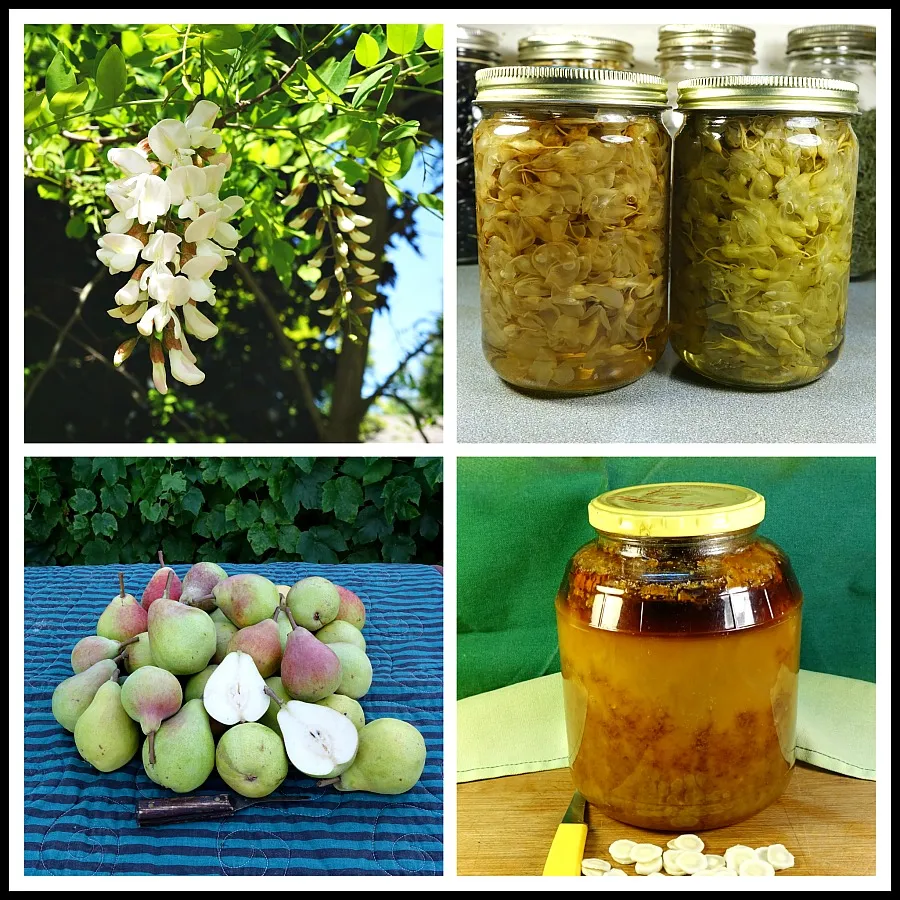 Top left: Black locust flowers. Top right: The black locust flowers soaking in 2 different brands of gin. Bottom left: Ubileen pears that ripen in early August. Bottom right: Honey from bees here on the homestead, harvested a few years ago. It's crystallizing, but honey stores for years.
Top left: Black locust flowers. Top right: The black locust flowers soaking in 2 different brands of gin. Bottom left: Ubileen pears that ripen in early August. Bottom right: Honey from bees here on the homestead, harvested a few years ago. It's crystallizing, but honey stores for years.
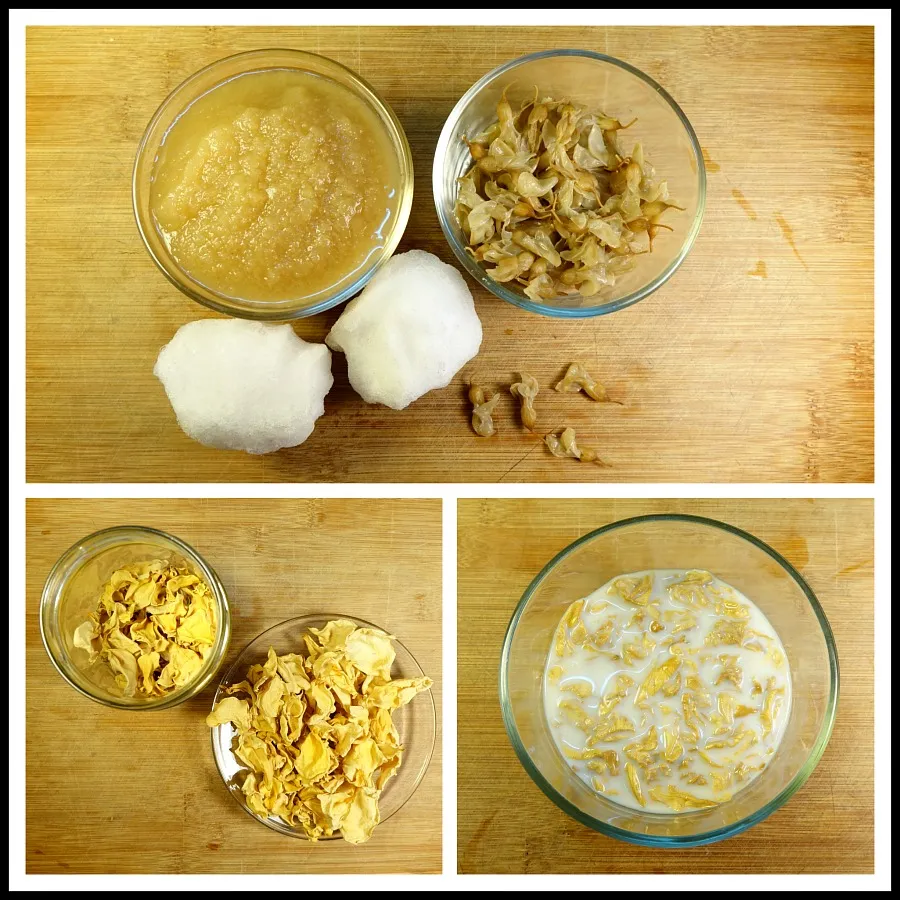 Top: That pear sauce on the left tastes like summer! When I remove the black locust flowers from soaking in the gin, they still have a lot of flavor. I store them in a separate jar in my freezer. With the snowballs! Bottom left: Dried rose petals. Bottom right: Rose petals soaking in milk. I ended up using almost the whole jar.
Top: That pear sauce on the left tastes like summer! When I remove the black locust flowers from soaking in the gin, they still have a lot of flavor. I store them in a separate jar in my freezer. With the snowballs! Bottom left: Dried rose petals. Bottom right: Rose petals soaking in milk. I ended up using almost the whole jar.
Because my Monochrome color is white, I wanted to use some wild carrots, too. Their roots are still in great condition, because the over-wintered plants still haven't kicked into their spring growth. Some of the roots I find are substantial, almost the size of garden carrots. Wild carrots are so under-appreciated!
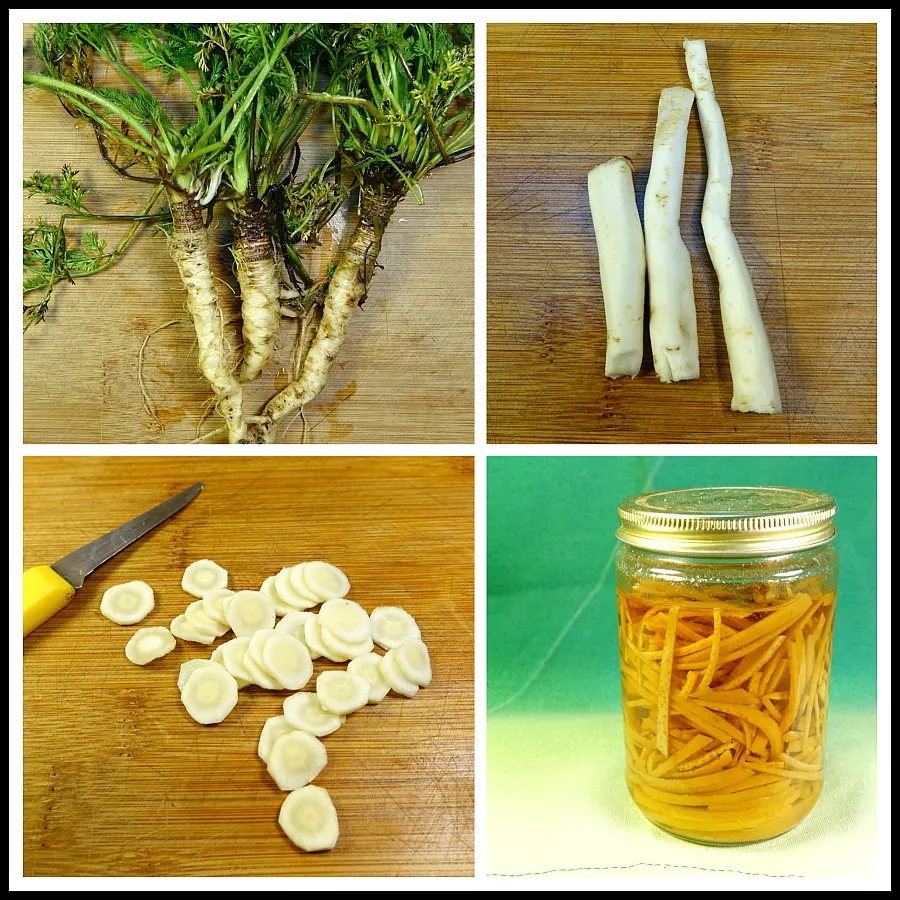 Top left: Wild carrot roots. Top right: Roots, lighly peeled and trimmed. Bottom left: Thinly sliced roots. You can see here how wild carrots are just like the domestic ones! Bottom right: I decided to flavor the carrots with brandy that I've been using to soak organic orange peels, from fruit my neighbors gave me after they returned from travels to Arizona.
Top left: Wild carrot roots. Top right: Roots, lighly peeled and trimmed. Bottom left: Thinly sliced roots. You can see here how wild carrots are just like the domestic ones! Bottom right: I decided to flavor the carrots with brandy that I've been using to soak organic orange peels, from fruit my neighbors gave me after they returned from travels to Arizona.
All Put Together
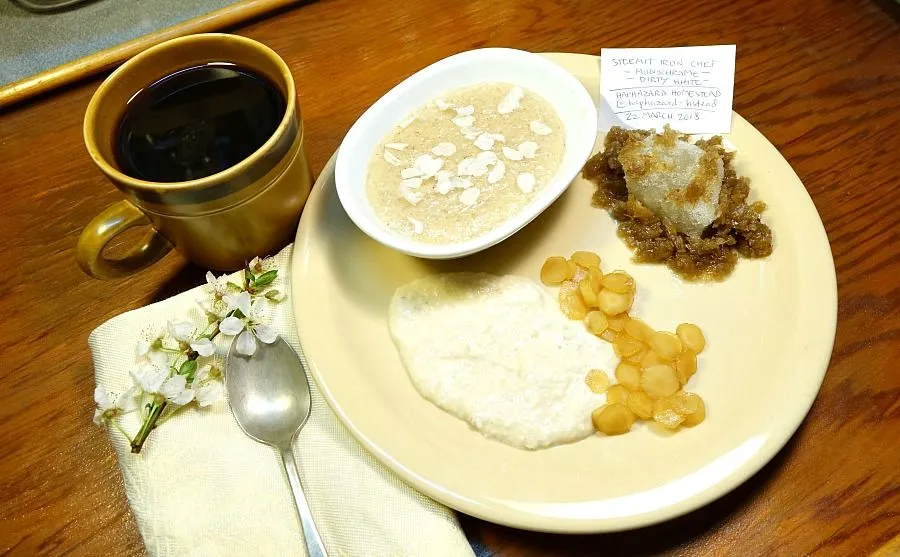 Not all white food is equally white! But at least they are each some shade or tone or tint of white! This all turned out to be a delicious combination of desserts! I will make and eat more of each one of these -- they are all so good!
Not all white food is equally white! But at least they are each some shade or tone or tint of white! This all turned out to be a delicious combination of desserts! I will make and eat more of each one of these -- they are all so good!
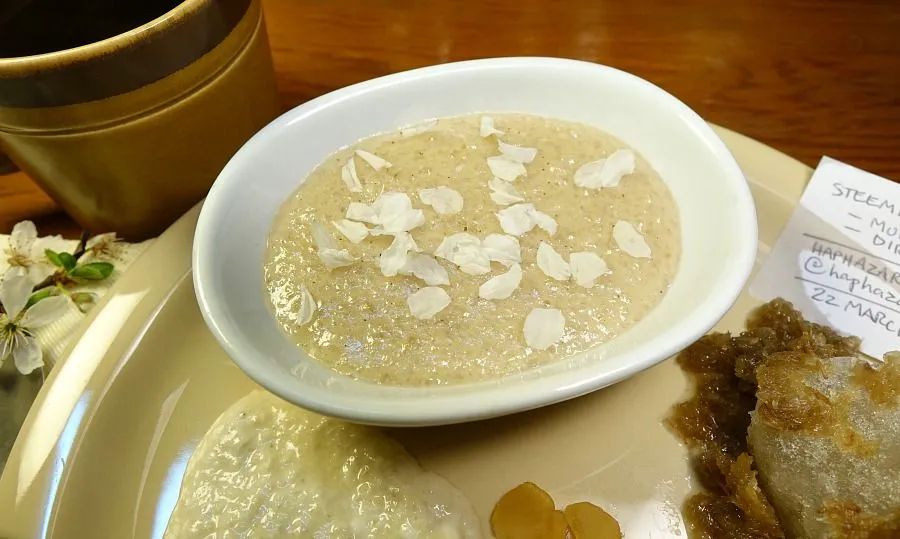 First up: Rose Petal Tapioca Pudding Topped with Plum Flowers. Ingredients: Rose petals soaked in milk, tapioca, egg, sugar. The rose flavor is incredible. It's a light flavor, but it has real depth, too. The flavor is as much up in my head as it is on my tongue. If you like the scent of rose cold cream, you would like this rose petal tapioca pudding!
First up: Rose Petal Tapioca Pudding Topped with Plum Flowers. Ingredients: Rose petals soaked in milk, tapioca, egg, sugar. The rose flavor is incredible. It's a light flavor, but it has real depth, too. The flavor is as much up in my head as it is on my tongue. If you like the scent of rose cold cream, you would like this rose petal tapioca pudding!
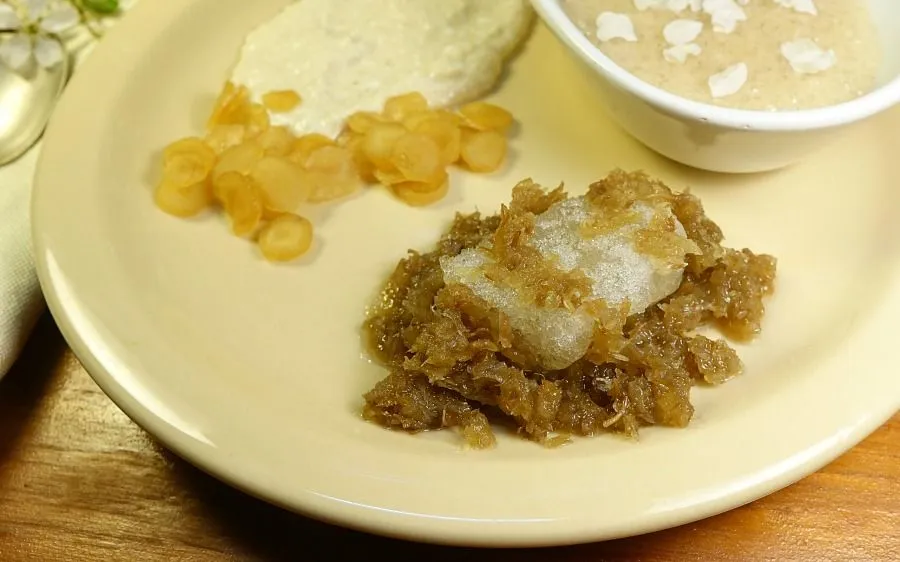 Next up: A Sweet Black Locust Gin Flower Snowball. I ground the black locust flowers to a paste, sweetened with sugar and powered-up with some of the flower-flavored gin. I cut a snowball in half and soaked it in the gin. This is a powerful dish! I ended up adding another whole snowball, cut in halves. This is so delicious -- and I got pretty looped! The snowball lasts a long time in that alcohol!
Next up: A Sweet Black Locust Gin Flower Snowball. I ground the black locust flowers to a paste, sweetened with sugar and powered-up with some of the flower-flavored gin. I cut a snowball in half and soaked it in the gin. This is a powerful dish! I ended up adding another whole snowball, cut in halves. This is so delicious -- and I got pretty looped! The snowball lasts a long time in that alcohol!
 Next up: Orange Brandy-Glazed Wild Carrots. With A Pear-Honey-Goat Cheese Spread. I steamed the wild carrots until they were tender, then slowly glazed them in the orange peel-flavored brandy, with just a touch of sugar. The spread is a simple mix of my pear sauce, honey, and goat cheese. They are both absolutely delicious! The pear mix is so summery. The carrots are so tender and have an amazing orange flavor! I was surprised how they took on an orange hue, after starting out so white!
Next up: Orange Brandy-Glazed Wild Carrots. With A Pear-Honey-Goat Cheese Spread. I steamed the wild carrots until they were tender, then slowly glazed them in the orange peel-flavored brandy, with just a touch of sugar. The spread is a simple mix of my pear sauce, honey, and goat cheese. They are both absolutely delicious! The pear mix is so summery. The carrots are so tender and have an amazing orange flavor! I was surprised how they took on an orange hue, after starting out so white!
 I wish you could try this mix of desserts! They are so good! I'm glad I put some of my summer harvests -- wild and garden-grown -- in my larder to use later!
I wish you could try this mix of desserts! They are so good! I'm glad I put some of my summer harvests -- wild and garden-grown -- in my larder to use later!
What Do You Think?
- Do you save any of your summer harvests to use later?
- Have you ever cooked with rose petals or black locust flowers?
- Do you ever forage wild carrots?
- Would you eat my plate of wild sweet white desserts?
I eat a lot of wild plants and show you how, because I believe that we can all have lives that are richer, more secure, more grounded, and more interesting by getting to know the plants and the land around us – in our yards, our parks, and our wild places.
Thanks @progressivechef for creating the Steemit Iron Chef contest series!
I try to make content that's interesting! If you found this informative and helpful, please give it an upvote and a resteem.
Plant List
- Black locust tree - Robinia pseudoacacia - flowers
- Wild Carrot or Queen Anne's Lace - Daucus carota - 1st year roots
- Ubileen pears - Pyrus communis - fruit
- Rose - unknown yellow shrub rose - Rosa spp. - dried petals
- Snowballs! - Hydrogen dioxide - for the chemists, lol! ; )
Haphazard Homestead
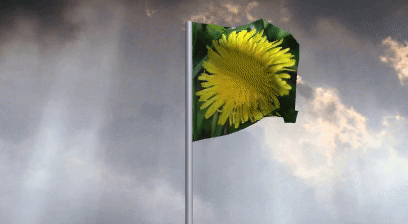 foraging, gardening, nature, simple living close to the land
All content is 100% Haphazard Homestead!My YouTube channel: Haphazard Homestead
foraging, gardening, nature, simple living close to the land
All content is 100% Haphazard Homestead!My YouTube channel: Haphazard Homestead








